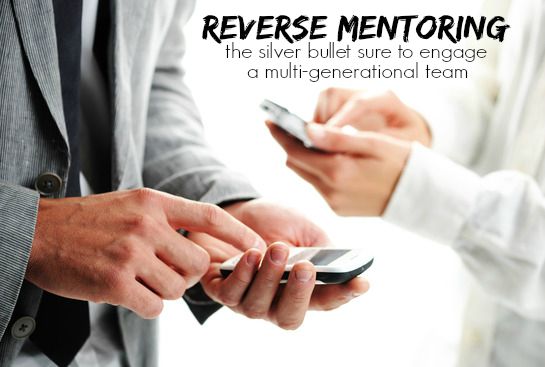If there was a silver bullet (there isn’t, but go with me here) to best engage your multi-generational team it would be reverse mentoring. Reverse mentoring creates diverse environments where individuals can communicate openly, provide insights, share ideas, and challenge legacy thinking.
What is reverse mentoring?
Reverse mentoring is a learning relationship where senior executives or veteran employees are paired with younger employees who then share their insights on technology, social media, and the latest workplace trends.
Unlike traditional mentoring, in which the mentor is always a senior individual who can pass on experience without much risk of pushback from the mentee, reverse mentoring provides an environment where information and insights can freely flow and where the organizational hierarchy is flattened.
Related Read: Reverse Your Stagnation With Reverse Mentoring
Who is using reverse mentoring?
Jack Welch, while CEO at GE, was credited for being one of the first adopters of reverse mentoring. Welch selected a junior employee to mentor him and then mandated that 500 of his executives find a reverse mentor. Since then other large companies including HP, The Hartford, Cisco, and Coca-Cola have initiated reverse mentoring programs.
According to Thomas Koulopoulos and Dan Keldsen, authors of "The Gen Z Effect: The Six Forces Shaping the Future of Business," mentoring is used in 56% of a 600 company sample polled by Delphi Group. Yet of those 600 companies only 14% had a reverse mentoring program in place, even though 51% of those companies have cross-generational teams.
Why isn’t reverse mentoring more widely used?
- Leaders are unaware of the benefits.
- Leaders are already engaged in peer-to-peer mentoring.
- Leaders are pressured to focus on tasks with clear ROI.
- Leaders lack the time.
- Leader's pride get in the way.
Reverse mentoring will become more and more important as the workplace becomes more and more generational diverse as Generation Z soon enters the workforce.
How to begin reverse mentoring?
- Make a list of 5 things you don’t know but need to know.
- Identify 1 or 2 items from the list that you are most likely not to learn on your own or during your course of work.
- Identify a junior colleague that has the expertise you need.
- Ask the junior colleague to mentor you.
- Clarify where to meet, frequency, expectations, etc.
- Prepare by identifying a set of questions before the first meeting. (Don’t be afraid to ask naive questions.)
- Meet and mentor.
Related Read: How To Use Mentoring In Your Workplace [Guest Post]
For reverse mentoring to work, avoid reciprocal mentorship. Do 100% of the learning. Think beyond having someone mentor you on social media, consider having them teach you something you think you already know, such as leadership.
When you decide to engage in reverse mentoring, you may also receive invaluable insights that reflect your consumer base or employee population. You will also be setting an example of continuous learning and hopefully demonstrating the strong communication skills that so many Millennials desperately need.
Disrupt and expand your perspective with reverse mentoring.
Question: Do you have a reverse mentor? Why or why not?
Consider Ryan Jenkins to be your next Millennial/Generation Y or Generation Z keynote speaker by clicking here...
![]()






